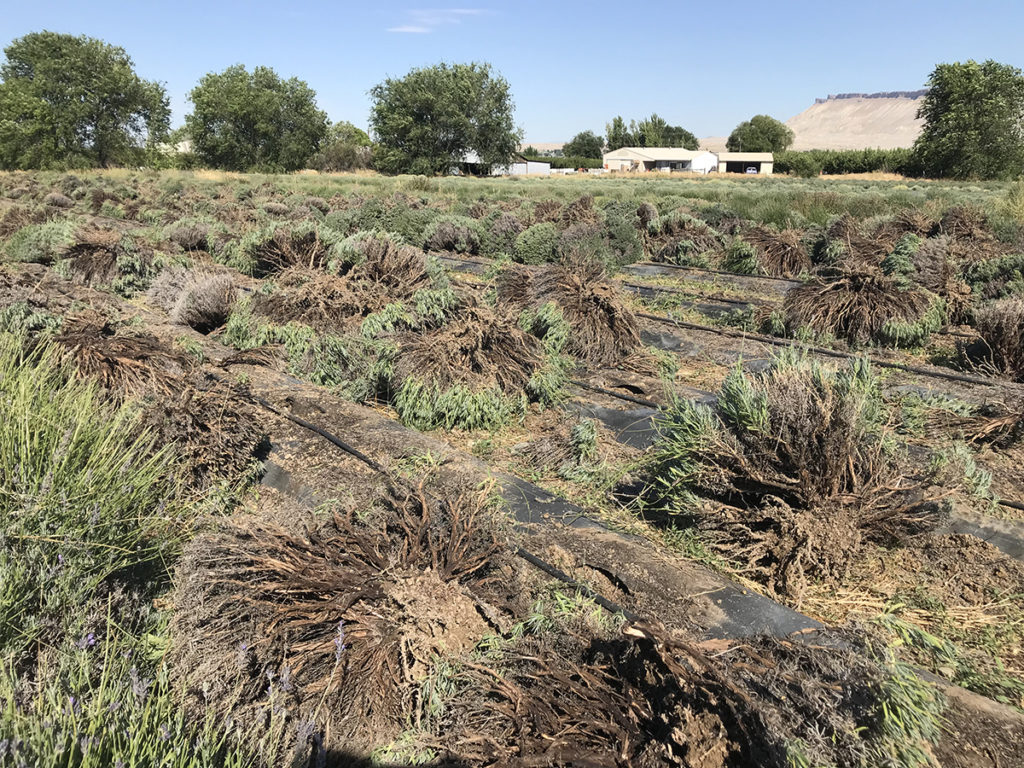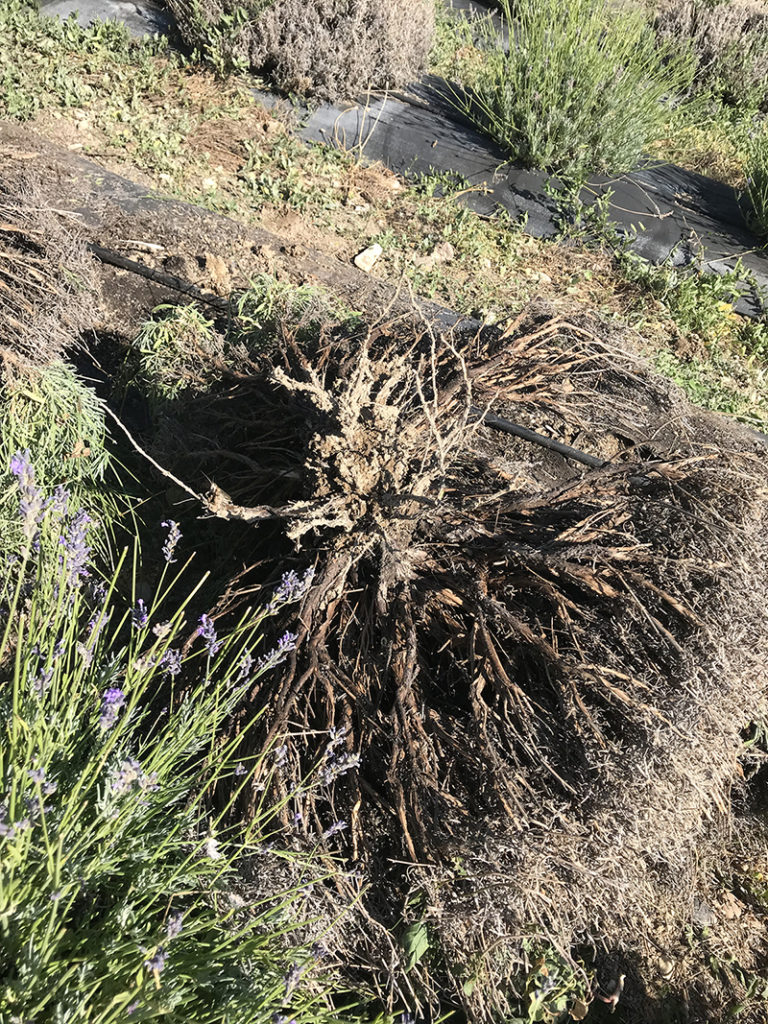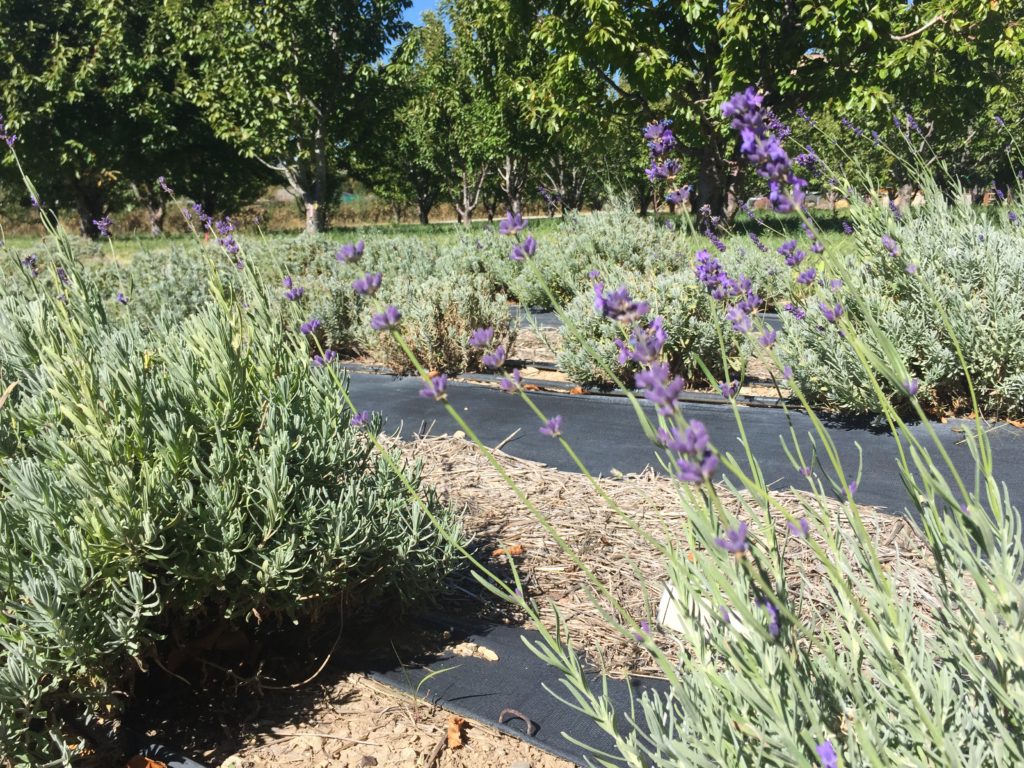Lavender’s a hardy plant, but it’s not invincible. Growing lavender on a large scale, you can expect to lose plants every year, either while they’re dormant in the winter or even during the growing season. We lost lavender plants this summer, as many have.
This isn’t only true for large-scale growers, though. Even home gardeners can experience losing a lavender plant.
In this post, we’re talking about re-planting: How do you know if a lavender plant is dead? And when’s the best time to re-plant lavender?

This year, we removed a few rows of True Grosso – 7-year old plants
Here are a few things to consider as you plan out your planting:
 When do you decide to remove a plant that is low-performing?
When do you decide to remove a plant that is low-performing?
Lavender plants go dormant in the winter, and sometimes it takes them a while to show signs of life come spring. Always wait until at least May before deciding that a plant is dead! You don’t want to pull out plants pre-maturely. It’s better to wait a bit longer and see if a plant will bounce back, especially when it comes to lavender and other perennials.
When to decide to pull your plants out and replant can also can be determined if it is diseased or has severe die back and is performing marginally.
How do you dispose of dead plants?
Whenever possible, compost dead plants so they can return to the soil. If diseased, remove and burn.
Should you replant right away (in fall) or wait until spring?
Lavender plants need 8-10 weeks in the ground to get established before winter arrives. Depending on your zone, and how much time you have before your first freeze, fall planting can be a great option. Planting lavender in the fall often pays off, as plants thrive come spring. On the other hand, planting in the spring is less risky.
Should you replant in the same location?
Replanting lavender in the same location is totally fine. Just mix in some fresh compost and even a small amount of slow-releasing natural fertilizer when you re-plant.
If you’re waiting until spring to re-plant, should you plant a cover crop?
If you are removing plants on a large scale, consider tilling the soil, seeding a cover crop and perform a soil test where you will be re-planting to see what soil nutrient deficiencies may exist. Cover crops never hurt. If you’re waiting until spring to re-plant and are using a cover crop to cover bare soil through the winter, try an annual winter-killed cover crop like vetch, peas and oats or winter rye. The cold temperatures of winter will kill the cover crop, but only after they grow a bit during fall to provide a nice blanket over your soil. Avoid planting perennial cover crops, as they’ll come back in the spring and compete with your new lavender plants.

If you’ve lost any lavender plants this year, here’s what you can do now to prepare for a re-planting in the spring.
1. Pull plants and prepare the soil
Pulling out dead plants and preparing the soil now, rather than waiting until spring, not only makes spring planting and easier job, but also helps to replenish your soil as we enter into winter months.
So, right now, you can pull dead plants and get the soil ready for re-planting lavender in spring.
2. Plan your next steps
Now that your soil’s ready, lay out your irrigation plan before planting anything new.
In another blog post, we outlined step-by-step how to prepare a bed for planting lavender. It’s all about designing with the end in mind.
Know your soil and understand lavender’s need for well-draining soil and full sun. Plan out the proper spacing, and consider what you’ll use to control weeds. The type of irrigation you want to use is another important consideration.
Ready to prepare for your spring planting?
Get exactly the cultivars you love most by pre-ordering plants now!
Order plants before October 15th and receive a 5% discount.
Reduced pricing available for orders of 160 plants or more.


Susan
If I harvest in late July in Rhode Island will I get some re-growth? I need some for a wedding in Sept. Thanks
Janet thomas
My lavender plants have died had to give a good cut i think that i will have to dig them as there was a lot of woody stems will they revive or should I get them up and replant thank you Mrs Janet Thomas